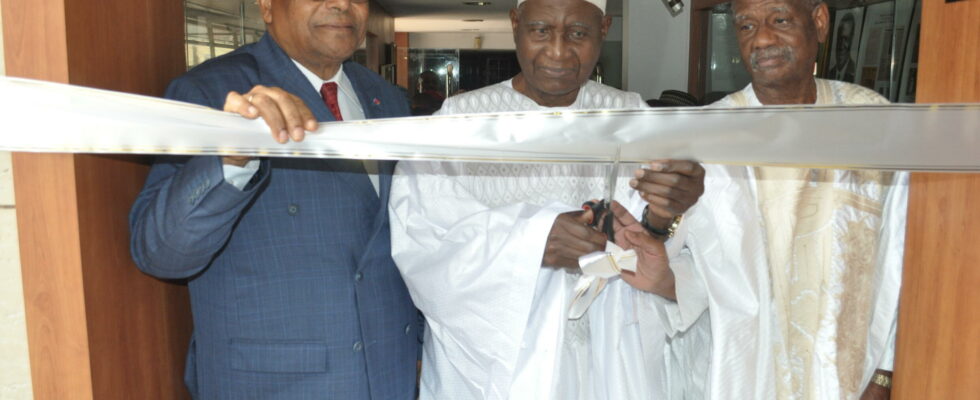An exhibition in memory of the first president of Cameroon (1960-1982), on the occasion of the hundredth anniversary of his birth, is being organized in Yaoundé. And this, even though his political heirs shine by their discretion and silence around this political figure who has been resting in the Muslim cemetery of Dakar since his death in 1989 in Senegal.
From our correspondent in Yahoundé,
Salomon-Tandeng-Muna Foundation, in downtown Yaoundé. In this place, Ahmdaou Ahidjo lives again through the magic of the archives. The very first president of the Cameroon would have been 100 years old on August 24, 2024. Significant parts of his public life are on display.
Here, a photo gallery presents him in the company of leading figures in Cameroonian political life. There, another shows him with world-class personalities, including prestigious counterparts. Right next to it, a third part of the exhibition is made up of first pages of editions of Cameroon Tribune“government daily”, created in 1974.
Since the opening of this exhibition dedicated to the life of Ahidjo on August 23, the site has seen a parade of politicians, researchers and curious onlookers. We are organizing ourselves to also interest students from high schools and colleges in the city, who have just returned to school. “, explains Ndika Tandjong, head of the foundation.
” We cannot act as if the history of Cameroon began in 1982 »
On the first floor, Akere Muna, the initiator of this memorial project, is not a little proud of it. This is all the more important [d’organiser cette exposition] that no activity has been organized in his name since his departure. So I made the decision to do it because we cannot continue to write our history with an eraser. Our goal is to honor our history: the current president is in place thanks to Ahidjo. We cannot continually act as if the history of our country began in 1982. [année où Paul Biya, jusque-là Premier ministre, succède à Ahmadou Ahidjo à la tête du pays, en conformité avec la Constitution alors en vigueur, NDLR] “, reveals the internationally renowned lawyer.
Also readRFI Knowledge – Portrait of Ahmadou Ahidjo (1/8)
The silence of Ahidjo’s political heirs is all the more telling, and their fortunes are diverse. In a way, Paul Biya, 91, is the most emblematic of all. On November 6, 1982, the day he ascended to the supreme office, he made “a great and vibrant homage filled with deference and admiration ” to his predecessor. And states: ” There is no better way to show our loyalty to him than to follow his example, to follow in his footsteps. So, […] I intend to place the action of the years to come under the dual sign of commitment and loyalty. »
The sequence of events rather highlighted a memorable falling out between the two politicians, divided over the conduct of the country’s affairs, on the preeminence of the State or of the Cameroon National Union (UNC), the single party of which Ahidjo remained president for a few months after leaving power. Subsequently, the rupture was consummated when Paul Biya successfully undertook the conquest of the UNC in 1983, before victoriously organizing the early presidential election of January 14, 1984.
Political heirs with varying fortunes
Sign of the times? It was Bello Bouba Maïgari, another political heir of Ahmadou Ahidjo, who cut the symbolic ribbon to open the exhibition in memory of Cameroon’s first president. The political trajectory of the current Minister of State for Tourism and Leisure reveals a certain inconstancy. Appointed Prime Minister by Paul Biya on November 6, 1982, he only held this position until June 18, 1983.
He was accused of having tried to organize the collective resignation of ministers from the northern part of the country in order to put Paul Biya in difficulty. Then came the time of exile in neighboring Nigeria, from where he returned in 1991, to, in 1992, take the reins of the National Union for Democracy and Progress (UNDP), a political party that had until then been led by Samuel Eboua, former secretary general of the presidency under Ahidjo, of whom he was also seen as a political heir, but of lesser stature.
Subsequently, Bello Bouba, elected as a member of parliament in March 1992, ran in the presidential election of October of the same year, against Paul Biya. He was ranked third at the end of the vote. In 1997, he boycotted the presidential election, but signed with the Cameroon People’s Democratic Movement – the RDPC, of Paul Biya – a ” government platform “, thanks to which he entered the government on December 7, as Minister of State, in charge of Industrial and Commercial Development.
Since then, while changing portfolios, he has lost neither his protocol rank nor his seat in the government. Having become an unwavering ally of Paul Biya, he gave up running in the presidential elections, while committing the UNDP to the elections for the election of deputies, senators and municipal councilors. A strategy that has paid off: this party, which benefits from a certain anchorage in the northern part of Cameroon, is considered the second political force in the country, after the RDPC, at the end of the 2020 municipal elections.
The fact remains that this political visibility contrasts with the timidity of a work of memory on Ahmadou Ahidjo, whose remains Bello Bouba Maïgari has so far been unable to obtain the return of to Cameroon. On this issue, two other particular political figures have not had more success: Mohamadou Ahidjo, eldest son of the first president, influential member of the UNDP, and roving ambassador to the presidency on the one hand, and Aminatou Ahidjo, daughter of the late president, registered with the RDPC, and president of the Board of Directors of the Palais des Congrès in Yaoundé, a public establishment. Many people see this as at leasta resounding failure.
